NCERT Solutions For Class 10 Science Chapter 6 Life Processes: In this article, you will find all the necessary information regarding NCERT Solutions For Class 10 Science Chapter 6 Life Processes. Students who are planning to build their career stream in the field of medicine can refer to this article as biology plays a major role in the medical field. Candidates having strong command over life processes class 10 NCERT solutions will be able to easily crack the competitive exams like NEET, AIIMS, JIPMER, etc.,
Did you check the Life Process Important Questions which were given in the previous Board Papers?
In this article, we have covered all the important topics in the exercises and each answer comes with a detailed explanation to help the class 10 students to understand concepts better. Read on to find out everything about NCERT class 10 science book activities solutions chapter 6.
NCERT Solutions for Class 10 Science Chapter 6 Life Processes
Before getting into the details of NCERT Solutions For Class 10 Science Chapter 6 Life Processes, let’s have an overview of topics and subtopics under class 10 science chapter 6 activities solutions:
- Life Processes
- What Are Life Processes?
- Nutrition
- Respiration
- Transportation
- Excretion
Free download NCERT Solutions for Class 10 Science Chapter 6 Life Processes PDF in Hindi Medium as well as in English Medium for CBSE, Uttarakhand, Bihar, MP Board, Gujarat Board, and UP Board students, who are using NCERT Books based on updated CBSE Syllabus for the session 2019-20.
- जैव-प्रक्रम कक्षा 10 विज्ञान हिंदी में
- Life Processes Class 10 Notes
- Life Processes NCERT Exemplar Solutions
- Life Processes Class 10 Extra Questions
- Class 10 Life Processes Mind Map
NCERT Solutions for Class 10 Science Chapter 6 Intext Questions
Page Number: 95
Question 1
Why is diffusion insufficient to meet the oxygen requirements of multicellular organisms like humans ?
Answer:
In multicellular organisms like humans, all the body cells are not in direct contact with the surrounding environment. Therefore, every cell of the body will not get oxygen as per need by the process of diffusion from the environment. Therefore diffusion is insufficient to meet the oxygen requirements of multicellular organisms.
Question 2
What criteria do we use to decide whether something is alive ?
Answer:
The main criteria used to decide whether something is alive are breathing and respiration. However, living beings also show growth and movement.
Question 3
What are outside raw materials used by an organism ?
Answer:
Any organism uses organic molecules as raw material. Heteroptrophs use food and autotrophs use carbon dioxide, minerals, water and all organisms use oxygen (for respiration) as raw materials.
Question 4
What processes would you consider essential for maintaining life ?
Answer:
Processes essential for maintaining life are :
(i) Nutrition
(ii) Respiration
(iii) Transportation
(iv) Excretion
Page Number: 101
Question 1
What are the differences between autotrophic nutrition and heterotrophic nutrition ?
Answer:
| Autotrophic nutrition | Heterotrophic nutrition |
| (i) In this mode of nutrition an organism makes or synthesizes its own food. | (i) In this mode of nutrition an organism cannot make or synthesize its own food |
| Organisms use simple inorganic materials like carbon dioxide and water and synthesise their food in presence of sunlight. | (ii) Organisms cannot make their own food from simple inorganic matter and depend on other organisms for their food. |
| (iii) All green plants and some algae undergo this mode of nutrition. | (iii) All the animals, most bacteria and fungi undergo this mode of nutrition. |
Question 2
Where do plants get each of the raw materials required for photosynthesis ?
Answer:
(i) Carbon dioxide : Plants get carbon dioxide from the environment/atmosphere through stomata.
(ii) Water : Plants absorb water from the soil through roots and transport to leaves.
(iii) Sunlight : Plants get sunlight from the sun.
(iv) Chlorophyll : It is present in chloroplast found in green leaves and green parts of plants.
Question 3
What is the role of the acid in our stomach ?
Answer:
Role of acid in our stomach is :
(i) To make acidic medium which is necessary for the activation of the enzyme pepsin.
(ii) To kill bacteria which the food may contain.
Question 4
What is the function of digestive enzymes ?
Answer:
The food we eat is complex in nature, i.e., it contains complex molecules. Digestive enzymes break down these complex molecules into smaller simpler molecules so that they can be absorbed by the walls of the intestine.
Question 5
How is the small intestine designed to absorb digested food ?
Answer:
The small intestine is designed to provide maximum area for absorption of digested food and its transfer into the blood for its circulation into the body. For this the inner lining of the small intestine has numerous finger-like projections called villi. The villi are richly supplied with blood vessels which take the absorbed food to each and every cell of the body.
Page Number: 105
Question 1
What advantage over an aquatic organism does a terrestrial organism have with regard to obtaining oxygen for respiration ?
Answer:
Aquatic organisms use oxygen dissolved in surrounding water. Since air dissolved in water has fairly low concentration of oxygen, the aquatic organisms have much faster rate of breathing.
Terrestrial organisms take oxygen from the oxygen-rich atmosphere through respiratory organs. Hence, they have much less breathing rate than aquatic organisms.
Question 2
What are the different ways in which glucose is oxidised to provide energy in various organisms ?
Answer:
First step of breakdown of glucose (6 carbon molecules) takes place in the cytoplasm of cells of all organisms. This process yields a three carbon molecule compound called pyruvate.
Further break down of pyruvate takes place in different ways in different organisms.
(i) Anaerobic respiration : The anaerobic respiration in plants (like yeast) produces ethanol and carbon dioxide as end products.
(ii) Aerobic respiration : In aerobic respiration break down of pyruvate takes place in presence of oxygen to give rise three molecules of carbon dioxide and water. The release of energy in aerobic respiration is much more than in anaerobic respiration.
(iii) Lack of oxygen : Sometimes, when there is lack of oxygen especially during physical exercise, in our muscles, pyruvate is converted into lactic acid (3 carbon molecule compound). Formation of lactic acid in muscles causes cramp.
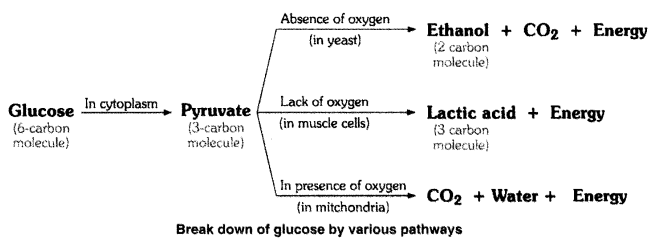
Question 3
How is oxygen and carbon dioxide transported in human beings ?
Answer:
(i) Transport of oxygen : Haemoglobin present in the blood takes up the oxygen from the air in the lungs. It carries the oxygen to tissues which are deficient in oxygen before releasing it.
(ii) Transport of carbon dioxide : Carbon dioxide is more soluble in water. Therefore, it is mostly transported from body tissues in the dissolved form in our blood plasma to lungs. Here it diffuses from blood to air in the lungs.
Question 4
How are the lungs designed in human beings to maximise the area for exchange of gases ?
Answer:
Within the lungs, the air passage divides into smaller and smaller tubes, called bronchi which in turn form bronchioles. The bronchioles terminate in balloon-like structures, called alveoli. The alveoli present in the lungs provide maximum surface for exchange of gases. The alveoli have vary thin walls and contain an extensive network of blood vessels to facilitate exchange of gases.
Page Number: 110
Question 1
What are the components of the transport system in human beings ? What are the functions of these components ?
Answer:
The transport system (circulatory system) in human beings mainly consists of heart, blood and blood vessels.
(i) Function of heart : The heart receives deoxygenated blood from the body parts and pumps it to lungs for enriching with oxygen. It receives purified blood from lungs and pumps it around the body.
(ii) Function of blood : Blood transports oxygen, carbon dioxide, digested food, hormones and nitrogeneous waste like urea. It also protects the body from diseases and regulates the body temperature.
(iii) Function of blood vessels : The blood pushed by the heart flows through the blood vessels (arteries, veins and capillaries) and also comes back to the heart through them.
Question 2
Why is it necessary to separate oxygenated and deoxygenated blood in mammals and birds ?
Answer:
Separation of oxygenated and deoxygenated blood allows good supply of oxygen to the body. This system is useful in animals that have high energy requirement. Mammals and birds constantly need oxygen to get energy to maintain their body temperature constant.
Question 3
What are the components of the transport system in highly organised plants?
Answer:
In highly organised plants there are two conducting tissues xylem and phloem.
Xylem consists of vessels, tracheids and other xylem tissues. The interconnected vessels and tracheids form a continuous system of water conducting channels reaching all parts of the plant. Xylem carries water and minerals.
Phloem conducts soluble products of photosynthesis from leaves to different parts of the plant body.
Question 4
How are water and minerals transport in plants ? [AICBSE 2015]
Answer:
The roots of a plant have hair called root hair.
The root hair are directly in contact with the film of water in between the soil particles. Water and dissolved minerals get into the root hair by the process of diffusion. The water and minerals absorbed by the root hair from the soil pass from cell to cell by osmosis through the epidermis, root cortex, endodermis and reach the root xylem.
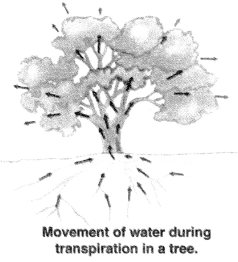
The xylem vessels of the root of the plant are connected to the xylem vessels of its stem.
Therefore the water containing dissolved minerals enters the root xylem vessels into stem xylem vessels. The xylem vessels of the stem branch into the leaves of the plants. So, the water and minerals carried by the xylem vessels in the stem reach the leaves through the branched xylem vessels which enter from the petiole (stalk of the leaf) into each and every part of the leaf. Thus the water and minerals from the soil reach through the root and stem to the leaves of the plants. Evaporation of water molecules from the cells of a leaf creates a suction which pulls water from the xylem cells of roots. The loss of water in the form of vapour from the aerial parts of the plant is known as transpiration.
Question 5
How is food transported in plants ?
Answer:
The movement of food in phloem (or translocation) takes place by utilizing energy. The sugar (food) made in leaves is loaded into the sieve tubes of phloem tissue by using energy from ATR Water now enters the sieve tubes containing sugar by the process of osmosis due to which the pressure in the phloem tissue rises. This high pressure produced in the phloem tissue moves the food to all parts of the plant having less pressure in their tissues. This allows the phloem to transport food according to the needs of the plant.
Page Number: 112
Question 1
Describe the structure and functions of nephrons.
Answer:
Structure of nephron : Each nephron is composed of two parts. First one is a cup-shaped bag at its upper end which is called Bowman’s capsule.
The Bowman’s capsule contains a bundle of blood capillaries which is called glomerulus. One end of the glomerulus is attached to the renal artery which brings the impure blood containing the urea waste into it. These impurities are filtered. The other part of the nephron is coiled. In this part, the substances like sugar (glucose), amino acid, ions and excess water which are required by the body, are reabsorbed. The substance remained in the nephron is mainly urine containing dissolved urea in water which is expelled from the body through urethra from time to time.
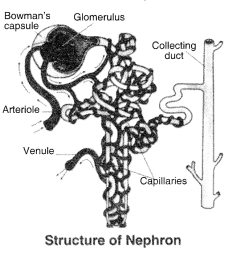
Functions of nephron : Filtration of blood takes place in Bowman’s capsule from the capillaries of glomerulus. The filtrate passes into the tubular part of the nephron. This filtrate contains glucose, amino acids, urea, uric acid, salts and water.
Reabsorption : As the filtrate flows along the tubule, useful substances such as glucose, amino acids, salts and water are selectively reabsorbed into the blood by capillaries surrounding the nephron tubule.
Urine : The filtrate which remained after reabsorption is called urine. Urine contains dissolved nitrogenous waste like urea and uric acid, excess salts and water. Urine is collected from nephrons to carry it to the ureter from where it passes into urinary bladder.
Question 2
What are the methods used by plants to get rid of excretory products ?
Answer:
(i) The plants get rid of gaseous products-through stomata in leaves and lenticels in stems.
(ii) The plants get rid of stored solid and liquid waste by the shedding off leaves, peeling off bark and felling off fruits.
(iii) The plants get rid of wastes by secreting them in the form of gums and resins.
(iv) Plants also excrete some waste substances into the soil around them.
Question 3
How is the amount of urine produced regulated ?
Answer:
The amount of urine is regulated by kidney. It depends on the quantity of excess water and wastes dissolved in water.
(i) Quantity of water : When water is abundant in the body tissues, large quantities of dilute urine is excreted out. When water is less in quantity in the body tissues, a small quantity of concentrate urine is excreted.
(ii) Quantity of dissolved wastes : Dissolved wastes, especially nitrogenous wastes, like urea and uric acid and salts are excreted from the body. When there is more quantity of dissolved wastes in the body, more quantity of water is required to excrete them. Therefore, the amount of urine produced increases.
(iii) Hormones : The amount of urine produced is also regulated by certain hormones which control the movement of water and Na+ ions in and out of the nephrons.
NCERT Solutions for Class 10 Science Chapter 6 Textbook Chapter End Questions
Question 1
The kidneys in human beings are a part of the system for
(i) nutrition
(ii) respiration
(iii) excretion
(iv) transportation
Answer:
(iii) Excretion
Question 2
The xylem in plants are responsible for
(i) transport of water
(ii) transport of food
(iii) transport of amino acids
(iv) transport of oxygen
Answer:
(i) Transport of water
Question 3
The autotrophic mode of nutrition requires
(i) carbon dioxide and water
(ii) chlorophyll
(iii) sunlight
(iv) all of the above
Answer:
(iv) All of the above
Question 4
The breakdown of pyruvate to give carbon dioxide, water and energy takes place in
(i) cytoplasm
(ii) mitochondria
(iii) chloroplast
(iv) nucleus
Answer:
(ii) Mitochondria
Question 5
How are fats digested in our bodies ? Where does this process take place ?
Answer:
Digestion of fats takes place in the small intestine.
Bile juice secreted by the liver poured in the intestine along with pancreatic juice. The bile salts present in the bile juice emulsify fhe large globules of fats. Therefore, by enulsification large globules break down into fine globules to provide larger surface area to act upon by the enzymes.
Lipase enzyme present in the pancreatic juice causes break down of emulsified fats. Glands present in the wall of small intestine secrete intestinal juice which contains lipase enzyme that converts fats into fatty acids and glycerol.

Question 6
What is the role of saliva in the digestion of food ?
Answer:
Saliva contains salivary amylase enzyme that breaks down starch into sugars like maltose.
![]()
Saliva keeps the mouth cavity clean and moistens the food that help in chewing and breaking down the big pieces of food into smaller ones.
Question 7
What are the necessary conditions (or autotrophic nutrition and what are its by-products ?
Answer:
Necessary conditions for autotrophic nutrition :
(i) Presence of chlorophyll in the living cells.
(if) Provision of supply of water to green plants or cells of the plant.
(iii) Sufficient sunlight.
(iv) Sufficient supply of carbon dioxide.
By-product of auto tropic nutrition is oxygen.
Question 8
What are the differences between aerobic and anaerobic respiration ? Name some organisms that use the anaerobic mode of respiration.
Answer:
| Aerobic respiration | Anaerobic respiration |
| 1. It takes place in the presence of oxygen. | 1. It takes place in the absence of oxygen. |
| 2. Complete breakdown of food occurs in aerobic respiration. | 2. Partial breakdown of food occurs in anaerobic respiration. |
| 3. The end products in aerobic respiration are carbon dioxide and water. | 3. The end products in anaerobic respiration may be ethanol and carbon dioxide (as in yeast plants) or lactic acid (as in animal muscles). |
| 4. Aerobic respiration produces a considerable amount of energy. | 4. Much less energy is produced in anaerobic respiration. |
Some organisms which use anaerobic respiration are yeast, bacteria etc.
Question 9
How are the alveoli designed to maximise the exchange of gases ?
Answer:
(i) The alveoli are thin walled and richly supplied with a network of blood vessels to facilitate exchange of gases between blood and the air filled in alveoli.
(ii) Alveoli have balloon-like structure. Hence, provide maximum surface for exchange of gases.
Question 10
What would be the consequences of a deficiency of haemoglobin in our bodies?
Answer:
Due to the deficiency of haemoglobin in blood, its oxygen carrying capacity decreases. As a result the production of energy by oxidation will become slower. Therefore, one would fall sick and would feel fatigue most of the time.
Question 11
Describe double circulation in human beings. Why is it necessary ?
Answer:
In our heart blood enters twice and also pumped out twice from the heart. The deoxygenated blood from the body is brought to the right atrium through vena cava from where it is sent to right ventricle. From right ventricle, the blood is pumped to the lungs for oxygenation through pulmonary artery. The oxygenated blood from lungs again enters the left atrium of the heart through pulmonary veins. From left atrium it is send to left ventricle, from where this oxygenated blood is pumped to different parts of body through the arteries. In this way the blood flows through the heart twice, that’s why it is called ‘double circulation’.
Necessity of double circulation: The right side and the left side of the human heart are useful to keep deoxygenated and oxygenated blood from mixing. This type of separation of oxygenated and deoxygenated blood ensures a highly efficient supply of oxygen to the body. This is useful in case of humans who constantly need energy to maintain their body temperature.
Question 12
What are the differences between the transport of materials in xylem and phloem ?
Answer:
| Xylem | Phloem |
| 1. Xylem conducts water and dissolved minerals from roots to leaves and other parts. | 1. Phloem conducts prepared food material from leaves to other parts of plant in dissolved form. |
| 2. In xylem, the transport of material takes place through vessels and tracheids which are dead tissues. | 2. In phloem, transport of material takes place through sieve tubes with the help of companion cells, which are living cells. |
| 3. In xylem upward movement of water and dissolved minerals is mainly achieved by transpiration pull. It is caused due to suction created by evaporation of water molecules from the cells of a leaf. | 3. In translocation, material is transferred into phloem tissue using energy from ATP. This increases the osmotic pressure that moves the material in the phloem to tissues which have less pressure |
Question 13
Compare the functioning of alveoli in the lungs and nephrons in the kidneys with respect to their structure and functioning.
Answer:
| Alveoli | Nephron |
| 1. Alveoli are functional unit of lungs. | 1. Nephrons are functional unit of kidney. |
| 2. A mature lung has about 30 crore alveoli. | 2. A kidney has about 10 lakh nephrons. |
| 3. Alveoli provide a wide surface for gaseous exchange. | 3. The surface area of a nephron is not much more. |
| 4. The exchange of O 2 and CO 2 takes place through the network of capillaries in alveoli. | 4. The Bowman’s capsule in nephron regulates the concentration of water and salts. |
NCERT Solutions for Class 10 Science Chapter 6 Life Processes
Life processes: ‘Living being’. Basic concept of nutrition, respiration, transport and excretion in plants and animals.
| Board | CBSE |
| Textbook | NCERT |
| Class | Class 10 |
| Subject | Science |
| Chapter | Chapter 6 |
| Chapter Name | Life Processes |
| Number of Questions Solved | 34 |
| Category | NCERT Solutions |
Question 1
How are fats digested in our bodies? Where does this process take place?
Solution:
The small intestine is the site of the complete digestion of carbohydrates, proteins and fats. It receives the secretions of the liver and pancreas for this purpose. The food coming from the stomach is acidic and has to be made alkaline for the pancreatic enzymes to act. Bile juice from the liver accomplishes this in addition to acting on fats. Fats are present in the intestine in the form of large globules, which make it difficult for enzymes to act on them. Bile salts break them down into smaller globules increasing the efficiency of enzyme action. The pancreas secretes pancreatic juice, which contains enzymes like trypsin for digesting proteins and lipase for breaking down emulsified fats. The walls of the small intestine contain glands, which secrete intestinal juice. The enzymes present in it finally convert the proteins to amino acids, complex carbohydrates into glucose and fats into fatty acids and glycerol.
Question 2
What is the role of saliva in the digestion of food?
Solution:
When we eat something we like, our mouth ‘waters’. This is actually not only water, but also a fluid called saliva secreted by the salivary glands. Another aspect of the food we ingest is its complex nature. If it is to be absorbed from the alimentary canal, it has to be broken into smaller molecules. This is done with the help of biological catalysts called enzymes. The saliva contains an enzyme called salivary amylase that breaks down starch, which is a complex molecule to give sugar. The food is mixed thoroughly with saliva and moved around the mouth while chewing by the muscular tongue.
More Resources for CBSE Class 10
Question 3
What are the necessary conditions for autotrophic nutrition and what are its byproducts?
Solution:
Carbon and energy requirements of the autotrophic organism are fulfilled by photosynthesis. It is the process by which autotrophs take in substances from the outside and convert them into stored forms of energy. This material is taken in the form of carbon dioxide and water, which is converted into carbohydrates in the presence of sunlight and chlorophyll. Carbohydrates are utilised for providing energy to the plant. The carbohydrates, which are not used immediately, are stored in the form of starch, which serves as the internal energy reserve to be used as and when required by the plant.
Download NCERT Solutions for Class 10 Science Chapter 6 Life Processes PDF
Question 4
What are the differences between aerobic and anaerobic respiration? Name some organisms that use the anaerobic mode of respiration.
Solution:
The food material taken in during the process of nutrition is used in cells to provide energy for various life processes. Diverse organisms do this in different ways – some use oxygen to breakdown glucose completely into carbon dioxide and water; some use other pathways that do not involve oxygen. In all cases, the first step is the breakdown of glucose, a six-carbon molecule, into a three-carbon molecule called pyruvate. This process takes place in the cytoplasm. Further, the pyruvate may be converted into ethanol and carbon dioxide. This process takes place in yeast during fermentation. Since this process takes place in the absence of air (oxygen), it is called anaerobic respiration. Breakdown of pyruvate using oxygen takes place in the mitochondria. This process breaks up the three-carbon pyruvate molecule to give three molecules of carbon dioxide. The other product is water. Since this process takes place in the presence of air (oxygen), it is called aerobic respiration. The release of energy in this aerobic process is a lot greater than in the anaerobic process.
Question 5
How are the alveoli designed to maximise the exchange of gases?
Solution:
Within the lungs, the passage divides into smaller and smaller tubes, which finally terminate in balloon-like structures, which are called alveoli. The alveoli provide a surface where the exchange of gases can take place. The walls of the alveoli contain an extensive network of blood vessels. As we have seen in earlier years, when we breathe in, we lift our ribs and flatten our diaphragm, and the chest cavity becomes larger as a result. Because of this, air is sucked into the lungs and fills the expanded alveoli. The blood brings carbon dioxide from the rest of the body for release into the alveoli, and the oxygen in the alveolar air is taken up by blood in the alveolar blood vessels to be transported to all the cells in the body. During the breathing cycle, when air is taken in and let out, the lungs always contain a residual volume of air so that there is sufficient time for oxygen to be absorbed and for the carbon dioxide to be released.
Question 6
Describe double circulation in human beings. Why is it necessary?
Solution:
The double circulatory system of blood flow refers to the separate systems of pulmonary circulation and the systemic circulation.
The adult human heart consists of two separated pumps, the right side with the right atrium and ventricle which pumps deoxygenated blood into the pulmonary circulation.
The oxygenated blood re-enters the left side of the heart through the pulmonary vein into the left atrium and passes to the left ventricle where it is pumped to the rest of the body. This part of the circulation is called as systemic circulation. This type of circulation is called double circulation. The advantage of a double circulatory system is that blood can be pumped to the rest of the body at a higher pressure.
Multiple Choice Questions (MCQs) [1 Mark each]
Question 1.
Yeast respires anaerobically using sugar as a substrate. Out of the options given below, choose the correct combination of condition and product?
| Condition | Product | |
| (a) | Aerobic | Alcohol |
| (b) | Aerobic | Lactic acid |
| (c) | Anaerobic | Alcohol |
| (d) | Anaerobic | Lactic acid |
Answer:
(c) Under an aerobic condition, yeast respires and converts glucose to alcohol and CO
2
.
Question 2.
The table shows the percentage composition of four samples of air. Which sample could have been breathed out by a person after vigorous exercise?
| Samples | Oxygen | Carbondioxide | Water Vapour |
| (a) | 16 | 0.3 | Saturated |
| (b) | 16 | 4 | Saturated |
| (c) | 21 | 0.03 | Trace |
| (d) | 21 | 3 | Trace |
Answer:
(b) This is because rapid aerobic respiration occurs – during vigorous exercise in order to obtain more energy.
Question 3.
Cramps caused during sudden activities are due to the formation of
(a) lactic acid
(b) acetic acid
(c) excess of water
(d) ethanol
Answer:
(a) Lactic acid is formed by the breakdown of pyruvate when oxygen is insufficient in muscles instead of forming C02 and water. Accumulation of excess lactic acid in the muscles causes cramps.
Question 4.
Which of the following plays nose like function in plants?
(a) Flower
(b) Phloem
(c) Stomata
(d) Chlorophyll
Answer:
(c) Stomata are pores which help in the passage of air in the plants.
Question 5.
Which changes occur when a person breathe in deeply?
| Diaphragm Muscle | External Intercostal Muscles | |
| (a) | Contracts | Contract |
| (b) | Contracts | No change |
| (c) | Relaxes | Contract |
| (d) | Relaxes | Relax |
Answer:
(a) When a person breathes deeply the external intercostal muscles contract causing the rib cage to swing up and out. Also, the diaphragm contracts and flattens causing the thoracic cavity to increase in volume and decrease in pressure.
Question 6.
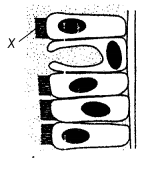
The diagram given above shows part of the lining of the human trachea. What is the function of X?
(a) Gaseous exchange
(b) Mucus removal
(c) Phagocytosis
(d) Secretion of mucus
Answer:
(b) The cilia (X) of the cells lining the air passages move in a sweeping motion to keep the air passages clean. The constant action of these cilia carry mucus and debris upward into the pharynx where they are swallowed.
Question 7.
The table given below shows the percentage composition of a gas in inspired and in expired air.
| %Composition | |
| Inspired Air | Expired Air |
| 21.0 | 16.0 |
What is the gas?
(a) Carbon dioxide
(b) Nitrogen
(c) Oxygen
(d) Water vapour
Answer:
(c) The gas is oxygen as atmospheric air has approximately 21% of oxygen
NCERT Solutions for Class 10 Science Chapter 6 Life Processes (Hindi Medium)
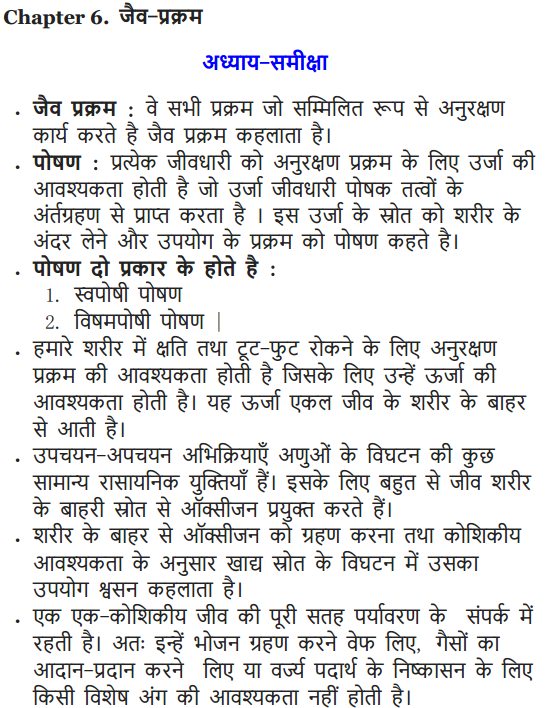
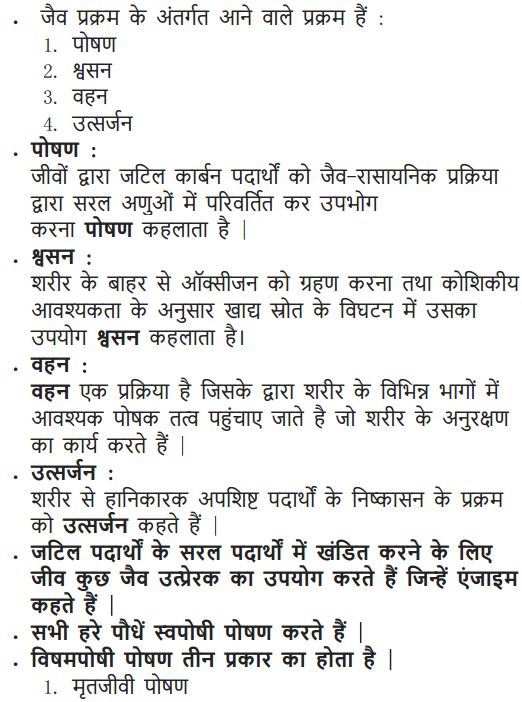
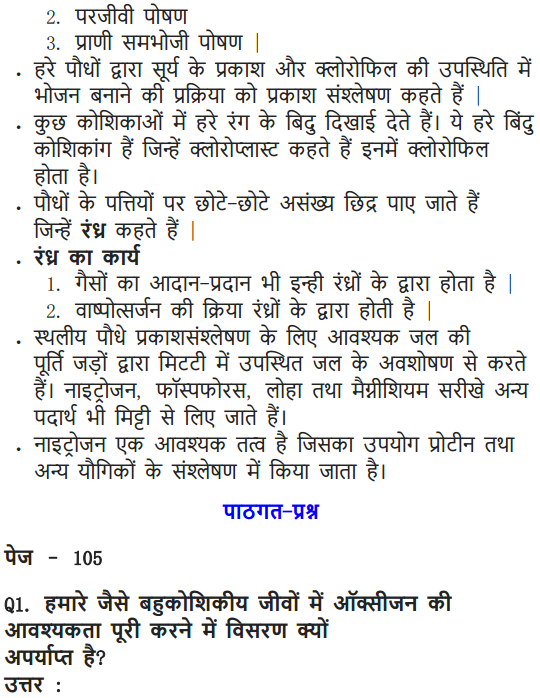
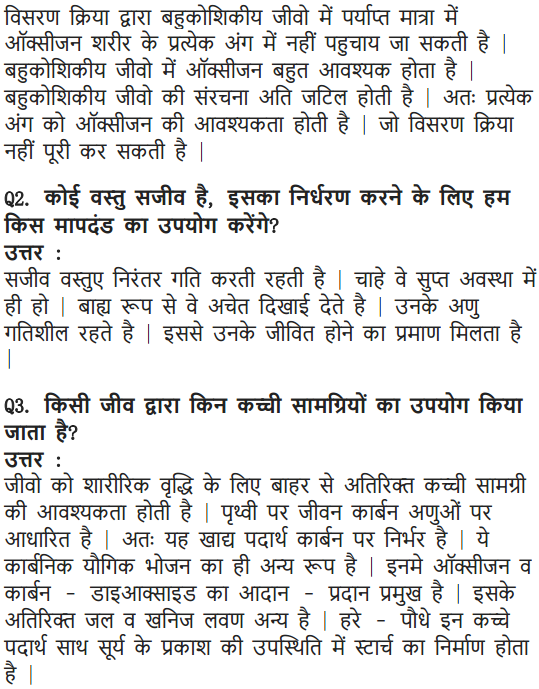
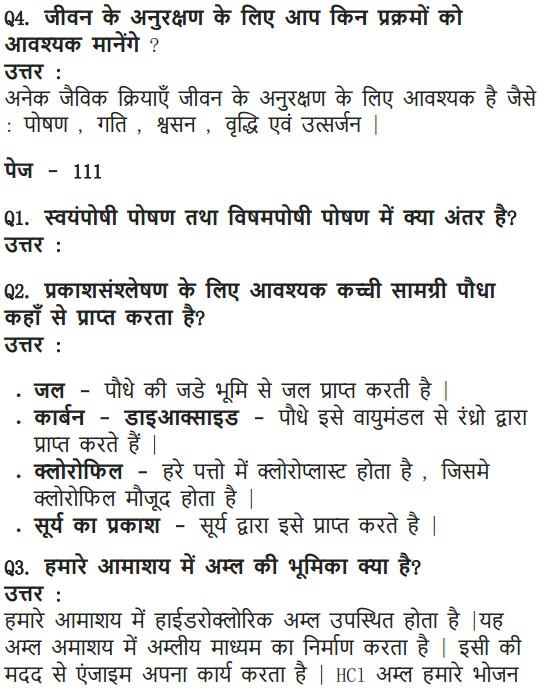
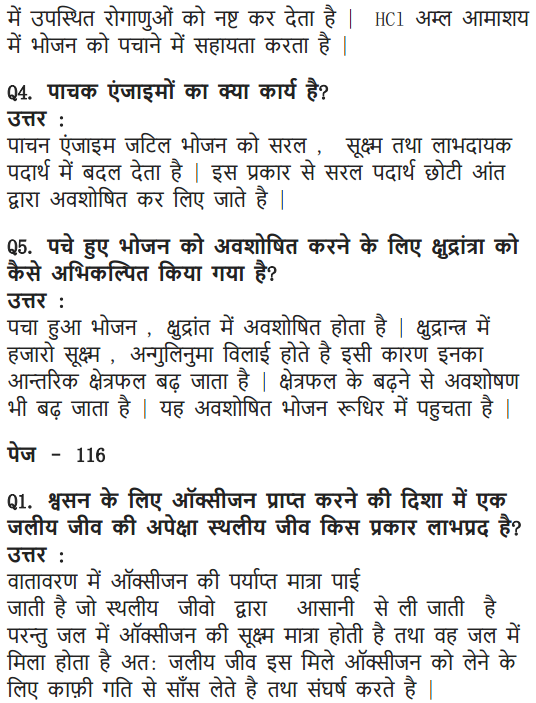
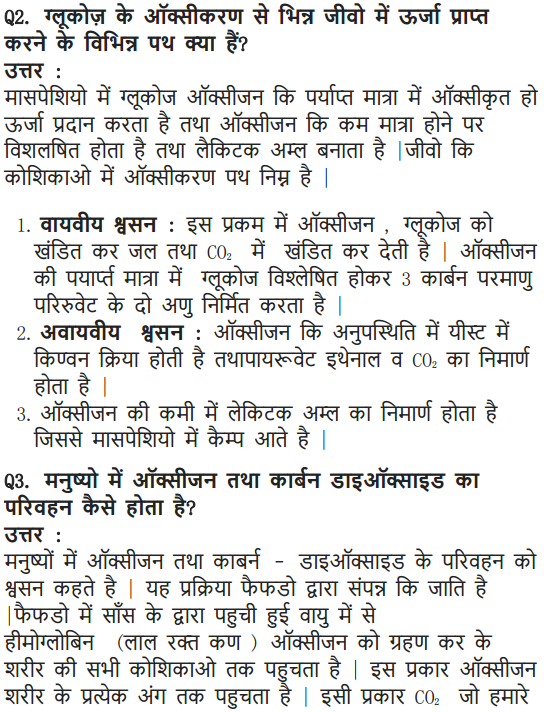
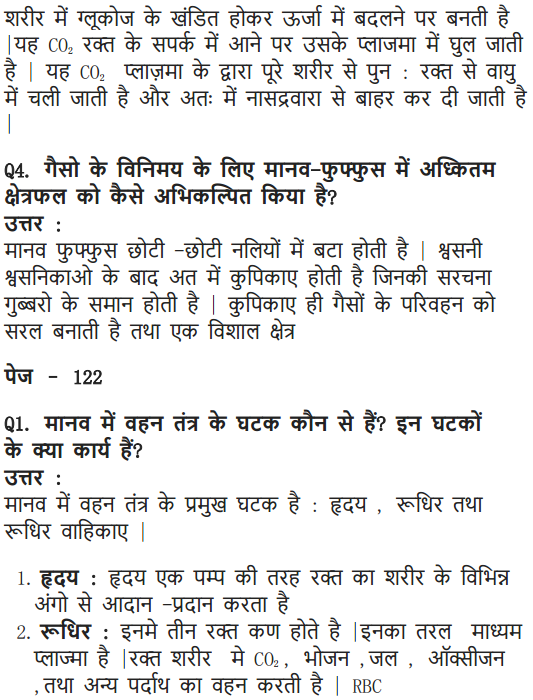
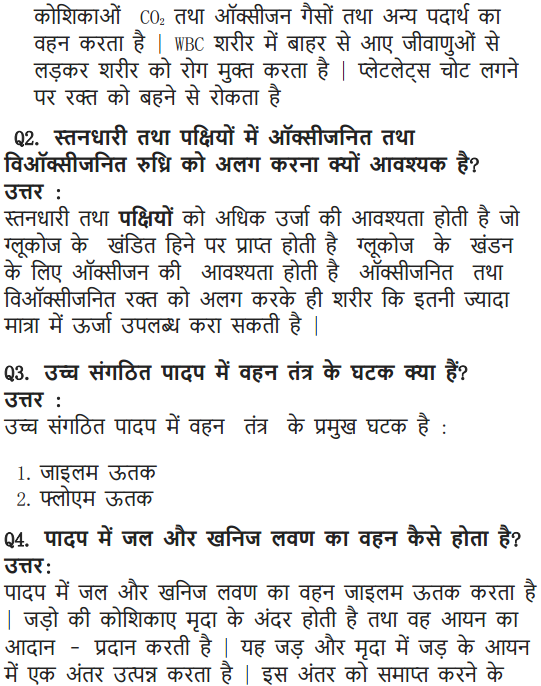
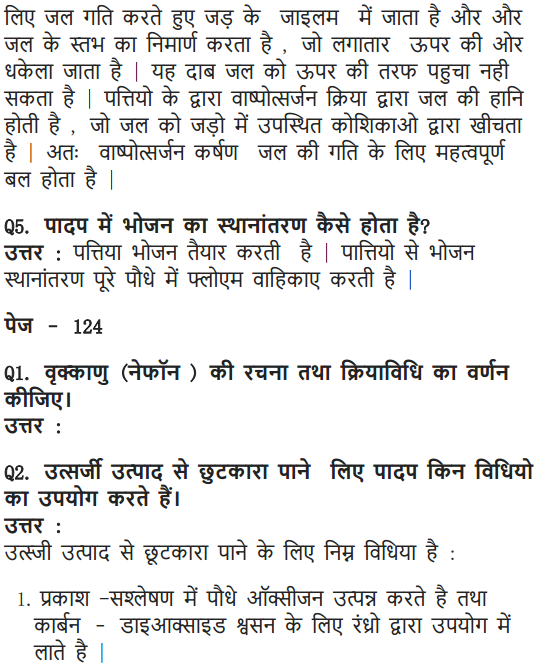
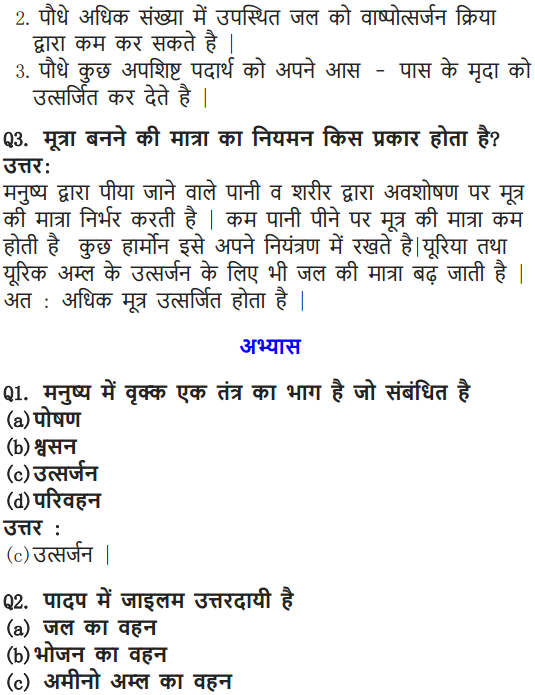
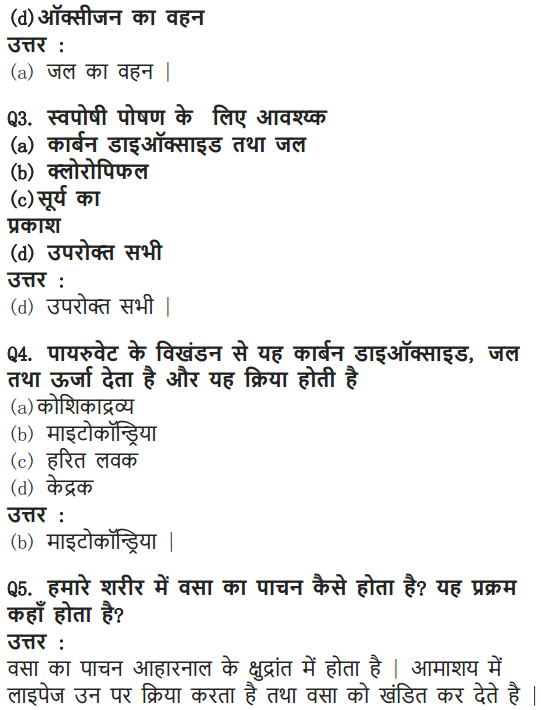
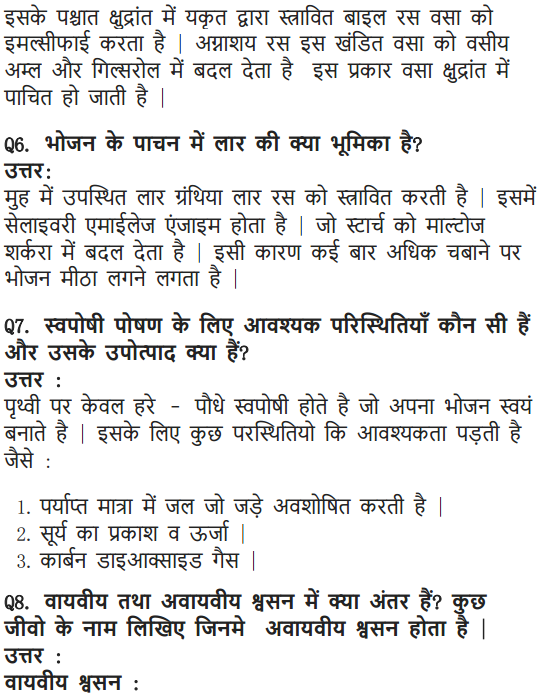
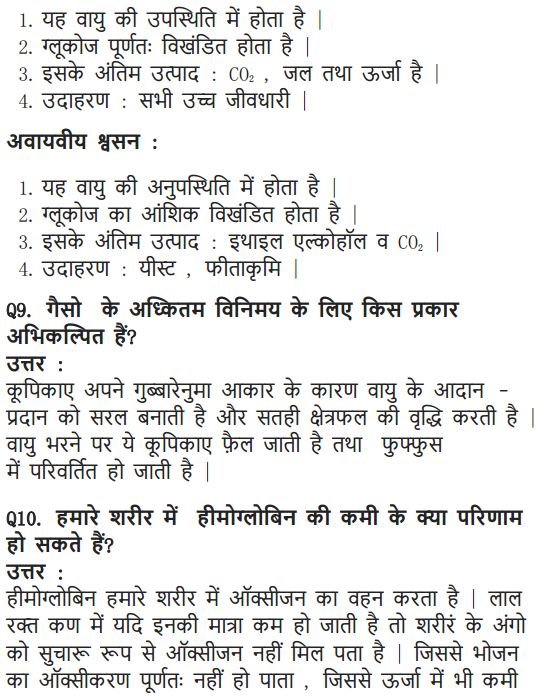
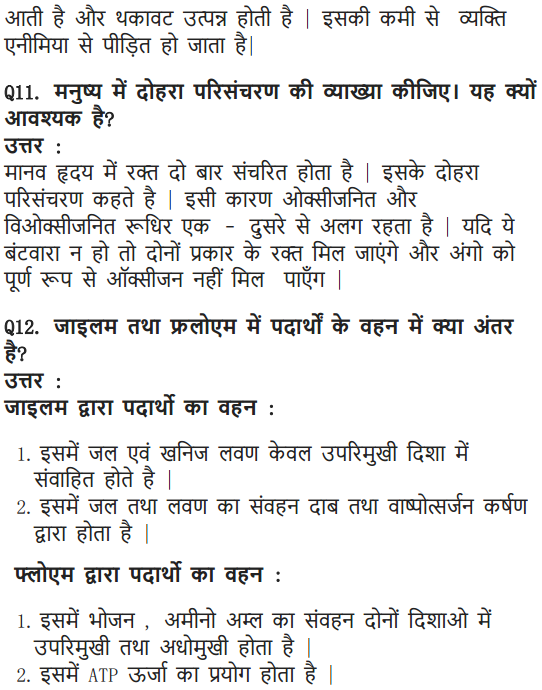
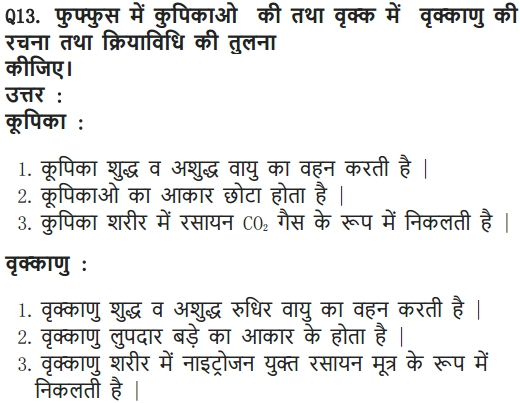
Class 10 Science Life Processes Mind Map
Nutrition
Nutrition is the process by which source of energy (food) is transferred from outside the body of the organism to the inside. Most of the food sources are also carbon-based on Earth and depending on the complexity of these carbon sources different organisms use different kinds of nutritional processes.
Autotrophic Nutrition:
Carbon and energy requirements of the autotrophic organism are fulfilled by photosynthesis.
- It is the process by which autotrophs convert carbon dioxide & water into carbohydrate in the presence of sunlight and chlorophyll. Oxygen is the byproduct.
- The following events occur during this process:
- Absorption of light energy by chlorophyll.
- Conversion of light energy to chemical energy and splitting of water molecules into hydrogen and oxygen.
- Reduction of carbon dioxide to carbohydrates.
Heterotrophic Nutrition: Heterotrophs depend on other organisms for their nutrition.
- Saprophytes: They break-down the food material outside the body and then absorb it, also termed as extra-cellular digestion. E.g. fungi like bread moulds, yeast, mushrooms etc.
- Parasites: Derive nutrition from plants or animals without killing them. E.g. cuscuta (amar-bel), ticks, lice, leeches, tape-worms etc.
- Holozoic nutrition: These organisms take in whole material & break it down inside their bodies. E.g. cow, deer, lion, tiger, humans etc. What can be taken in and broken down depends on body design and functioning
Respiration
It is the process by which organism uses the food material to produce energy. Diverse organisms do this in different ways:

Energy released during cellular respiration is immediately used to synthesise ATP which is used to fuel all other activities in the cell. Aerobic organisms need to ensure that there is sufficient intake of oxygen:
• Plants:
Exchange of gases takes place through stomata by simple diffusion. Large inter-cellular spaces ensure that all cells are in contact with air. Direction of diffusion depends upon the environmental conditions and the requirements of the plant. For e.g. CO
2
elimination majorly takes place at night while oxygen release is the major event of the day time.
• Aquatic animals
such as fishes take in water through their mouths & force it past the gills where the dissolved oxygen is taken up by blood.
• In human beings,
the passage of air can be written as nostril → trachea → bronchi → bronchioles → alveolar sac. The alveoli provide a surface where the exchange of gases can take place. Blood releases the dissolved CO
2
into the alveoli & carries O
2
from alveolar air. Haemoglobin in RBC of blood transport O
2
from lungs to various tissues of the body.
Life Process
The processes which maintain the body functions and are required for the survival of living being are called life processes. Some of the important life processes are nutrition, respiration, transportation, excretion etc.
Nutrition In Human Beings
The alimentary canal is a long tube extending from the mouth to the anus. The nutrition in human being is divided into five steps:
• Ingestion:
Intake of food from outside source. Teeth & saliva crush the food to generate the particles of same size & texture. The food is then passed to stomach via oesophagus. The peristaltic movements occur all along the gut which helps in pushing the food forward.
• Digestion:
In mouth, salivary amylase helps in carbohydrates digestion. In stomach, pepsin helps in protein digestion. However, small intestine is the main site of complete digestion of carbohydrates, proteins & fats. It receives pancreas and liver secretions. Bile juice emulsifies fats and pancreatic enzymes, trypsin & lipases digest proteins & emulsified fats. It finally converts proteins to amino acids, complex carbohydrates into glucose & fats into fatty acids & glycerol.
• Absorption:
The digested food is taken up by the walls of the intestine. The inner lining of the small intestine has numerous finger-like projections called villi which increase the surface area for absorption. Large intestine absorbs water from the unabsorbed food.
• Assimilation:
The villi are richly supplied with blood vessels which take the absorbed food to each & every cell of the body, where it is required either for energy, build up or repair.
• Excretion:
The waste material is removed from the body via anus which is regulated by anal sphincter.
Transportation
Transportation in Human Beings
-
Blood consists of fluid medium called plasma in which
the cells are suspended. Plasma transports food, CO 2 & nitrogenous wastes in dissolved form. Oxygen is carried by RBC. - Heart: Heart is the muscular organ made up of cardiac muscles and is as big as our fist. It is composed of four chambers (2 atria & 2 ventricles) to prevent the mixing of oxygenated & deoxygenated blood.
- Ventricles are thick wailed as they have to pump the blood to various organs of the body. In addition, valves are also present in heart and veins to prevent the backflow of the blood.
Circulation of blood: Oxygenated blood is carried out from lungs to the left atrium with the help of pulmonary’ veins.
-
Left atrium contracts to release blood into the left ventricle which relaxes while collecting it. It then pumped out the blood to whole body via aorta.
a Deoxygenated blood from whole body then enters the right atrium via vena cava vein. - Right atrium contracts to pump the blood in right ventricle. It then pumps the blood towards lungs via pulmonary’ artery for oxygenation.
Oxygenation of blood: Invertebrates such as birds, mammals etc which constantly use energy to maintain their body temperature, blood goes through heart twice during each cycle which is known as double circulation.
- In contrast, animals like amphibians or many reptiles have three-chambered hearts as they can tolerate some mixing of the oxygenated & de-oxygenated blood streams. They do not use energy for thermoregulation and body temperature depends on the temperature in the environment.
- Fishes, on other hand, have only two chambered heart. Blood is pumped to the gills for oxygenation and passes directly to the rest of the body.
Transportation In Plants
There are two main pathways present in plants: xylem pathway- moves water & minerals from the soil & phloem transports products of photosynthesis from leaves (where they are synthesized) to other parts of the plant.
Transport of Water
- In xylem tissue, vessels and tracheids of roots, stems & leaves are interconnected to form a continuous system of water-conducting channels reaching all parts of the plant.
- At root site, cells actively take up ions from soil which creates concentration gradient. Water then diffuses into the root cells in order to eliminate this gradient.
- It provides steady movement of water into root xylem, creating a column of water that is steadily pushed upwards.
- However, it is not efficient enough to push water over the heights of tall plants.
- So, plants use other method which is known as transpiration to push water upwards. The loss of water in the form of vapour from aerial parts of plant is known as transpiration.
- Evaporation of water molecules from the cells of a leaf creates a suction which pulls water from the xylem cells of roots. It also aids in thermoregulation.
- Transport of food and other substances
- Transport of soluble products of photosynthesis is called translocation.
- The translocation takes place in sieve tubes with the help of adjacent companion cells both in upward & downward directions.
- It utilizes energy (ATP) in contrast to xylem transport.
- Material like sucrose is transferred into phloem tissue using energy from ATP.
- It increases osmotic pressure of tissue causing water to move into it.
- This pressure moves the material in phloem to tissues which have less pressure.
- It allows phloem to move material according to plant’s needs.
Excretion
The biological process involved in removal of harmful metabolic wastes from body is called excretion.
Many unicellular organisms remove these wastes by simple diffusion from body surface into surrounding water. However, complex multi-cellular organisms use specialised organs to perform this function.
Excretion in Human Beings:
The excretory system includes pair of kidneys, pair of ureters, urinary bladder & urethra.
- Nephrons are the functional units of kidneys. They are the clusters of thin-walled capillaries. Each cluster is associated with cup-shaped end (Bowmans capsule) of a tube that collects the filtered urine.
- Substance such as glucose, amino acids, salts & a major amount of water are selectively re-absorbed as the urine flows along the tube. The amount of water depends up on amount of excess water & dissolved waste in the body.
- The urine formed in each kidney is carried to urinary bladder by ureter. Urine is stored in urinary bladder until the pressure of the expanded bladder leads to the urge to pass it out through the urethra.
- Excretion in Plants: They get rid of excess water by transpiration.
- Many plant waste products are stored in cellular vacuoles.
- Waste products may be stored in leaves that fall off.
- In addition, some waste products are stored as resins & gums, especially in old xylem.
- Lastly, plants excrete some waste substances into the soil around them.
We hope the detailed information regarding NCERT Solutions For Class 10 Science Chapter 6 Life Processes is helpful. For any query related to NCERT Solutions For Class 10 Science Chapter 6 Life Processes, kindly drop your questions in the comment box below and we will get back to you as soon as possible.
NCERT Solutions for Class 10 Science All Chapters
- Chapter 1 Chemical Reactions and Equations
- Chapter 2 Acids, Bases and Salts
- Chapter 3 Metals and Non-metals
- Chapter 4 Carbon and Its Compounds
- Chapter 5 Periodic Classification of Elements
- Chapter 6 Life Processes
- Chapter 7 Control and Coordination
- Chapter 8 How do Organisms Reproduce?
- Chapter 9 Heredity and Evolution
- Chapter 10 Light Reflection and Refraction
- Chapter 11 Human Eye and Colourful World
- Chapter 12 Electricity
- Chapter 13 Magnetic Effects of Electric Current
- Chapter 14 Sources of Energy
- Chapter 15 Our Environment
- Chapter 16 Management of Natural Resources